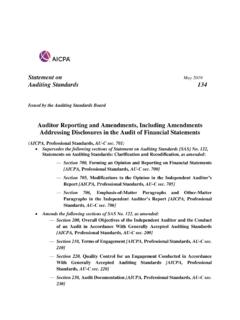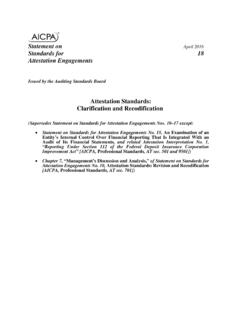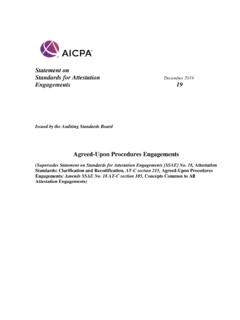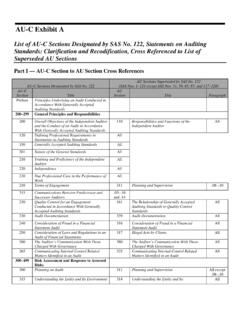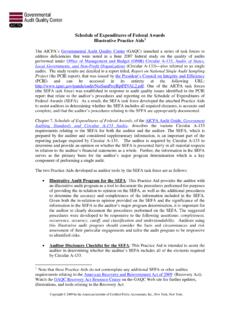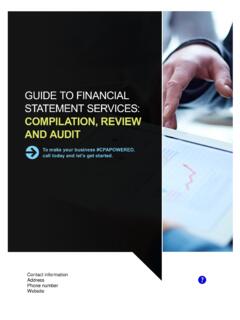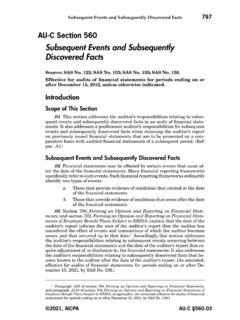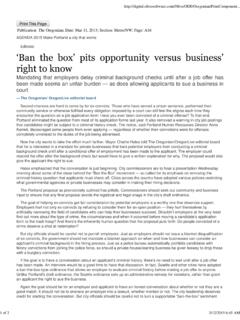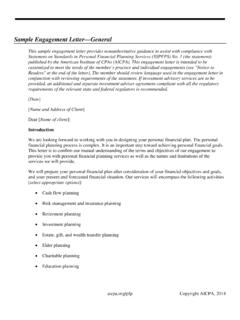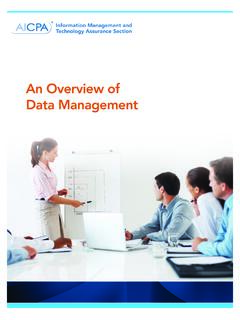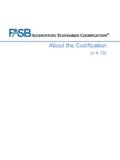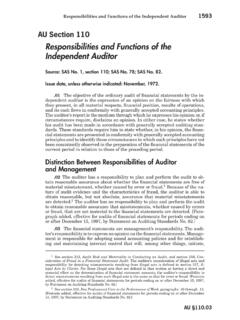Transcription of Auditing Accounting Estimates and Related Disclosures
1 Statement on July 2020. Auditing standards 143. Issued by the Auditing standards Board Auditing Accounting Estimates and Related Disclosures (Supersedes Statement on Auditing standards (SAS) No. 122, Statements on Auditing standards : Clarification and Recodification, as amended , section 540, Auditing Accounting Estimates , Including Fair Value Accounting Estimates , and Related Disclosures [AICPA, Professional standards , AU-C sec. 540]; Amends: SAS No. 122, as amended Section 200, Overall Objectives of the Independent Auditor and the Conduct of an Audit in Accordance With Generally Accepted Auditing standards [AICPA, Professional standards , AU-C sec. 200]. Section 230, Audit Documentation [AICPA, Professional standards , AU-C sec. 230]. Section 240, Consideration of Fraud in a Financial Statement Audit [AICPA, Professional standards , AU-C sec. 240]. Section 260, The Auditor's Communication With Those Charged With Governance [AICPA, Professional standards , AU-C sec. 260]. Section 501, Audit Evidence Specific Considerations for Selected Items [AICPA, Professional standards , AU-C sec.)]
2 501]. Section 580, Written Representations [AICPA, Professional standards , AU-C sec. 580]. SAS No. 134, Auditor Reporting and Amendments, Including Amendments Addressing Disclosures in the Audit of Financial Statements, as amended Section 700, Forming an Opinion and Reporting on Financial Statements [AICPA, Professional standards , AU-C sec. 700]. Section 701, Communicating Key Audit Matters in the Independent Auditor's Report [AICPA, Professional standards , AU-C sec. 701]. SAS No. 136, Forming an Opinion and Reporting on Financial Statements of Employee Benefit Plans Subject to ERISA, as amended [AICPA, Professional standards , AU-C ]). 2020 American Institute of Certified Public Accountants, Inc. All rights reserved. For information about the procedure for requesting permission to make copies of any part of this work, please email with your request. Otherwise, requests should be written and mailed to Permissions Department, 220 Leigh Farm Road, Durham, NC 27707-8110. Auditing standards Board (2019 2020).
3 Michael J. Santay, Chair Audrey A. Gramling Brad C. Ames Gaylen R. Hansen Monique Booker Tracy W. Harding Patricia Bottomly Jon Heath Jay D. Brodish, Jr. Kristen A. Kociolek Dora A. Burzenski G. Alan Long Joseph S. Cascio Sara Lord Harry Cohen Marcia L. Marien Jeanne M. Dee Aaron Saito Lawrence M. Gill Estimates Task Force Dora A. Burzenski, Chair Mike Lundberg Jeanne M. Dee Martin Hurden Doug Bennett Laura Schuetze Ilene Kassman AICPA Staff Robert Dohrer Linda Delahanty Chief Auditor Senior Manager Professional standards and Services Audit and Attest standards . Public Accounting Teighlor S. March Assistant General Counsel . Office of General Counsel Note: Statements on Auditing standards are issued by the Auditing standards Board, the senior technical body of the AICPA designated to issue pronouncements on Auditing matters. The Compliance With standards Rule (ET sec. )1 of the AICPA Code of Professional Conduct requires compliance with these standards in an audit of a nonissuer.
4 1. All ET sections can be found in AICPA Professional standards . CONTENTS. Paragraph Introduction Scope of This Statement on Auditing standards .. 1. Nature of Accounting Estimates .. 2 3. Key Concepts of This SAS .. 4 8. Effective Date .. 9. Objective ..10. Definitions .. 11. Requirements Risk Assessment Procedures and Related Activities .. 12 14. Identifying and Assessing the Risks of Material Misstatement .. 15 16. Responses to the Assessed Risks of Material Misstatement .. 17 30. Disclosures Related to Accounting Estimates .. 31. Indicators of Possible Management Bias .. 32. Overall Evaluation Based on Audit Procedures Performed .. 33 36. Communication With Those Charged With Governance, Management, or Other Relevant Parties .. 37. Documentation .. 38. Application and Other Explanatory Material Nature of Accounting Estimates .. A1 A7. Key Concepts of This SAS .. A8 A13. A14 A18. Risk Assessment Procedures and Related Activities .. A19 A63. Identifying and Assessing the Risks of Material Misstatement.
5 A64 A80. Responses to the Assessed Risks of Material Misstatement .. A81 A132. Indicators of Possible Management Bias .. A133 A136. Overall Evaluation Based on Audit Procedures Performed .. A137 A144. Written Representations .. A145. Communication With Those Charged With Governance, Management, or Other Relevant Parties .. A146 A147. Documentation .. A148 A151. Appendix A Inherent Risk Factors .. A152. Appendix B Communications With Those Charged With Governance .. A153. Appendix C Amendments to Various Sections in SAS No. 122, Statements on Auditing standards : Clarification and Recodification, as amended ; SAS No. 134, Auditor Reporting and Amendments, Including Amendments Addressing Disclosures in the Audit of Financial Statements, as amended ; and SAS No. 136, Forming an Opinion and Reporting on Financial Statements of Employee Benefit Plans Subject to ERISA, as amended .. A154. Statement on Auditing standards , Auditing Accounting Estimates and Related Disclosures Introduction Scope of This Statement on Auditing standards 1.
6 This Statement on Auditing standards (SAS) addresses the auditor's responsibilities relating to Accounting Estimates , including fair value Accounting Estimates and Related Disclosures , in an audit of financial statements. Specifically, it includes requirements and guidance that refer to or expand on how AU-C section 315, Understanding the Entity and Its Environment and Assessing the Risks of Material Misstatement;*AU-C section 330, Performing Audit Procedures in Response to Assessed Risks and Evaluating the Audit Evidence Obtained; AU-C section 450, Evaluation of Misstatements Identified During the Audit; and AU-C section 500, Audit Evidence, and other relevant AU-C sections are to be applied with regard to Accounting Estimates and Related Disclosures . It also includes requirements and guidance Related to the evaluation of misstatements of Accounting Estimates and Related Disclosures , and indicators of possible management bias. Nature of Accounting Estimates 2. Accounting Estimates vary widely in nature and are required to be made by management when the monetary amounts cannot be directly observed.
7 The measurement of these monetary amounts is subject to estimation uncertainty, which reflects inherent limitations in knowledge or data. These limitations give rise to inherent subjectivity and variation in the measurement outcomes. The process of making Accounting Estimates involves selecting and applying a method using assumptions and data, which requires judgment by management and can give rise to complexity in measurement. The effects of complexity, subjectivity, or other inherent risk factors on the measurement of these monetary amounts affects their susceptibility to misstatement. (Ref: par. A1 A6 and app. A). 3. Although this SAS applies to all Accounting Estimates , including fair value Accounting Estimates ,1 the degree to which an Accounting estimate is subject to estimation uncertainty will vary substantially. The nature, timing, and extent of the risk assessment and further audit procedures required by this SAS will vary in relation to the estimation uncertainty and the assessment of the Related risks of material misstatement.
8 For certain Accounting Estimates , estimation uncertainty may be very low, based on their nature, and the complexity and subjectivity involved in making them may also be very low. For such Accounting Estimates , the risk assessment procedures and further audit procedures required by this SAS would not be expected to be extensive. When estimation uncertainty, complexity, or subjectivity are very high, such procedures * All AU-C sections can be found in AICPA Professional standards . 1. For purposes of generally accepted Auditing standards , a fair value measurement is a form of Accounting estimate. would be expected to be much more extensive. This SAS contains guidance on how the requirements of this SAS can be scaled. (Ref: par. A7). Key Concepts of This SAS. 4. AU-C section 315 requires the auditor to assess the risk of material misstatement at the relevant assertion level. For this purpose, this SAS requires inherent risk and control risk to be assessed separately for Accounting Estimates .
9 Depending on the nature of a particular Accounting estimate, the susceptibility of an assertion to a misstatement that could be material may be subject to or affected by estimation uncertainty, complexity, subjectivity, or other inherent risk factors, and the interrelationship among them. As explained in AU-C section 200, Overall Objectives of the Independent Auditor and the Conduct of an Audit in Accordance With Generally Accepted Auditing standards ,2 inherent risk is higher for some assertions and Related classes of transactions, account balances, and Disclosures than for others. Accordingly, the assessment of inherent risk depends on the degree to which the inherent risk factors affect the likelihood or magnitude of misstatement and varies on a scale that is referred to in this SAS as the spectrum of inherent risk. In assessing control risk, the auditor takes into account whether the auditor's further audit procedures contemplate planned reliance on the operating effectiveness of controls.
10 If the auditor does not perform tests of controls, the auditor's assessment of the risk of material misstatement at the relevant assertion level cannot be reduced for the effective operation of controls with respect to the particular assertion. (Ref: par. A8 A10, A65 A66, and app. A). 5. This SAS refers to relevant requirements in AU-C sections 315 and 330 and provides Related guidance to emphasize the importance of the auditor's decisions about controls relating to Accounting Estimates , including decisions about whether there are controls relevant to the audit, for which the auditor is required to evaluate their design and determine whether they have been implemented. to test the operating effectiveness of relevant controls. 6. This SAS emphasizes that the auditor's further audit procedures (including, when appropriate, tests of controls) need to be responsive to the reasons for the assessed risks of material misstatement at the relevant assertion level, taking into account the effect of one or more inherent risk factors and the auditor's assessment of control risk.
